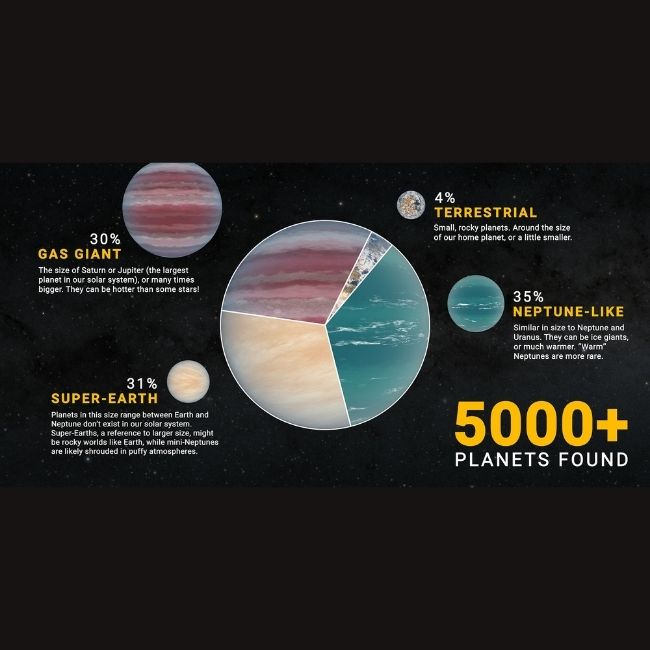
5000 Exoplanets discovered!
Recommended for Secondary Grades
The first exoplanet was discovered not too long ago in a galaxy close by. NASA confirmed 65 more exoplanets, bringing the total number of confirmed exoplanets to over 5,000. Astronomers have added the 5,000 exoplanets to the Jet Propulsion Laboratory (JPL). The JPL is part of the NASA Exoplanet Archive.
Scientists are eager to discover what lies beyond our Solar System.
Discovery of exoplanets – A clever approach!
Many of the exoplanets have been found by using a clever method. Scientists were able to tell when a planet passed in front of its star by looking for light rays with high-tech telescopes. Thus, if an exoplanet is found, the observer would be able to see a short drop in light intensity from their point of view.
This method is called the “transit method”. The majority of exoplanets have been found this way. Using this method could also give you more information than just the location of the exoplanet.
Early Discoveries!
In the early 1990s, the first exoplanets were found, and they were very far away. Astronomers have been able to get the number to 5,000. As per experts, these exoplanets are mostly in a little bubble around our solar system.
As of now, there are more than 5,000 exoplanets known, and 4,900 of them are within a few thousand light-years of us. Scientists believe there are a lot more planets in our galaxy that we haven’t found yet. There could be 100 to 200 billion of them. It’s mind-blowing!
Super-Earths and more!
As per experts, 1/3rd of the exoplanets discovered so far are called “Super-Earths”. These exoplanets are bigger than Earth but not as big as Neptune. In addition, there are only a few known exoplanets that are about the same size as Earth. Also, some may have features like rocks and oceans.
The curious case of Kepler-69c!
One of the planets (Kepler-69c) 2,700 light-years away has been found to be on the edge of its star’s habitable zone – a place where people could live.
Kepler-69c is closer to its star than Earth is, but that star is only about 80% as bright as our own. This could make it possible for it to support life.
Would you like to be an astronaut and make exciting discoveries? Do tell us your thoughts in the comments section.
Similar Stories
- Out-of-this-World Discovery: Planet Hops, Sun Swaps!
- A Treasure Hunt in Outer Space!
- Astronomers discover exoplanets’ heaviest element!
Curious Times is a leading newspaper and website for kids. We publish daily global news aligned to your learning levels (also as per NEP 2020): Foundational, Preparatory (Primary), Middle and Senior. So, check out the News tab for this. We bring kids’ favourite Curious Times Weekly newspaper every weekend with top news, feature stories and kids’ contributions. Check out daily JokesPoke, Tongue Twisters, Word of the Day and Quote of the Day, kids need it all the time.
ME – My Expressions at Curious Times is your place to get your work published, building your quality digital footprint. And it is a good way to share your talent and skills with your friends, family, school, teachers and the world. Thus, as you will step into higher educational institutes your published content will showcase your strength.
Events, Quizzes and Competitions bring students from over 5,000 schools globally to participate in the 21st-Century themes. Here schools and students win certificates, prizes and recognition through these global events.
Sign-up for your school for FREE!
Communicate with us: WhatsApp, Instagram, Facebook, Youtube, Twitter, and LinkedIn.
0 (Please login to give a Curious Clap to your friend.)
